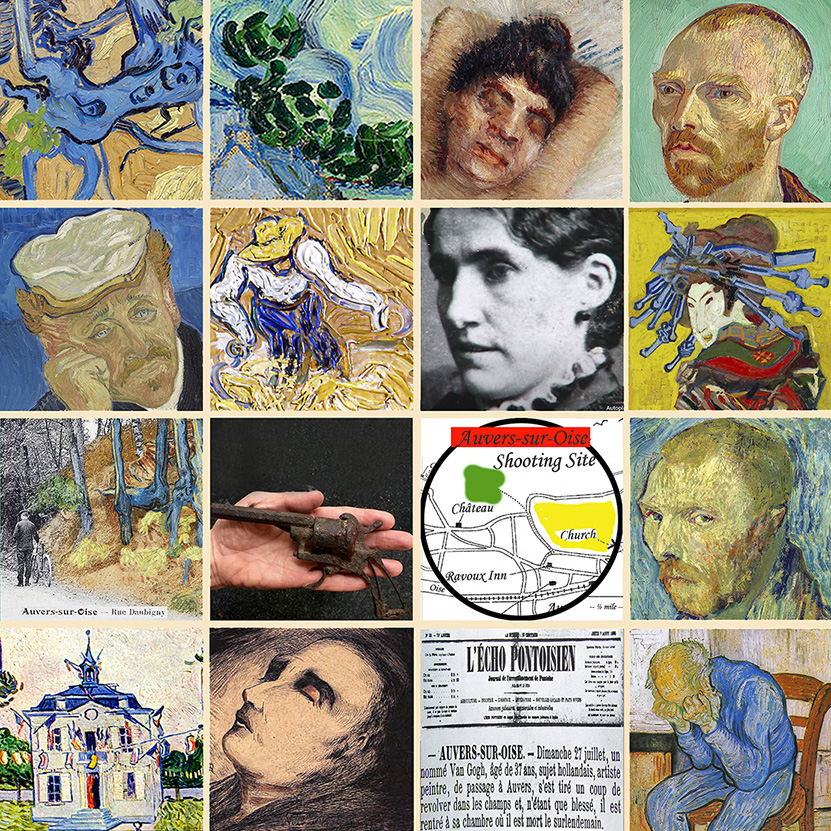


There are many different stories about the death of Vincent van Gogh, including a 300 page book with "made-up" forensic evidence about "his murder", a book produced by some American. And here we come with our story and our UNIQUE PROVES... So enjoy....
In the weeks before his suicide Vincent van Gogh made three paintings
with clearly explicit details that were pointing to his nearing death. With these three paintings he expressed what he didn't want or couldn't
scream out to the world around him. In secret Vincent painted his three
"Harbingers of his death". I'll write here about other paintings as well with vague hints about his suicide-plans and about Vincent losing his faith and hope in life.
As far as we can find, however the three paintings mentioned here below have clearly their straight focus on "death".
(1) He made "Towards Heaven" (official name is: Wheat Fields with Reaper).
(2) Shortly after this, he painted the "Skull in the trees watching over the field of execution." (official name: "View on Auvers with Church" at present in Rode-Island Museum USA).
(3) With the "TreeRoots" he finally terminated his "trilogy of death" on the 27th of July 1890; he painted this work on the very day
of his suicide attempt and only a few hours before he shot himself in his chest in the field behind the castle in Auvers-sur-Oise.
You'll read in our story how Vincent van Gogh expressed in his final paintings what he
secretly felt and planned and what he couldn't speak out. And how and why he
prepared himself to depart from this life on earth at an age of just 37 years.
Our storyline and interpretations are unique and the socalled "van Gogh-scholars" never
commented on our view.
It sure looks like Vincent did a well thought out and premeditated suicide. Read here and judge for yourself!!
Further in our report here I'll try to analyze how this gifted and well educated young man from a good family from the south of the Netherlands became such an astounding failure during his lifetime. It was only because of the yearslong and relentless efforts and prudent business management of his sister-in-law, Jo van Gogh-Bonger, that Vincent could reach the stardom he posthumously achieved. Mrs Jo Bonger deserves the spotlight in this great succes. Many insiders believe that without her we would never even have heard about Vincent van Gogh at all !! Here below a painting of mrs Jo Bonger by dutch painter Isaac Israëls.



We do have our unique interpretations of his paintings (as well as of his character) and our analyses are based on a long study of van Gogh's paintings and letters. We've found details in his paintings that nobody ever NEVER noticed in the 130 years that passed till today.
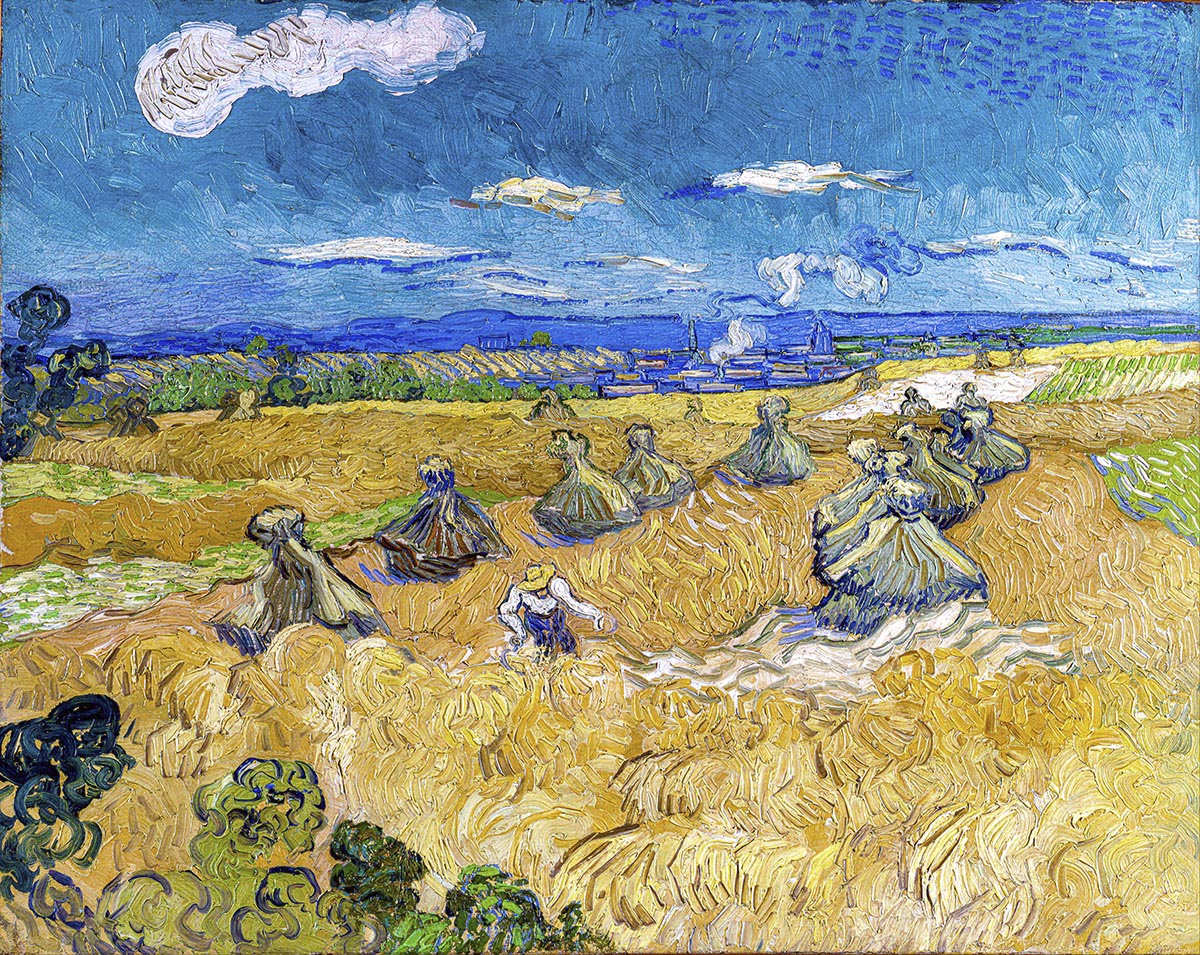 Reaper Vincent with two (2) reaper knives on his way to the white field in the distance.... this white field looks like a cloudy magic carpet that will carry him to heaven. Van Gogh never painted white fields.... the fields that he painted were always yellow, green, brown.... never white...
Reaper Vincent with two (2) reaper knives on his way to the white field in the distance.... this white field looks like a cloudy magic carpet that will carry him to heaven. Van Gogh never painted white fields.... the fields that he painted were always yellow, green, brown.... never white...
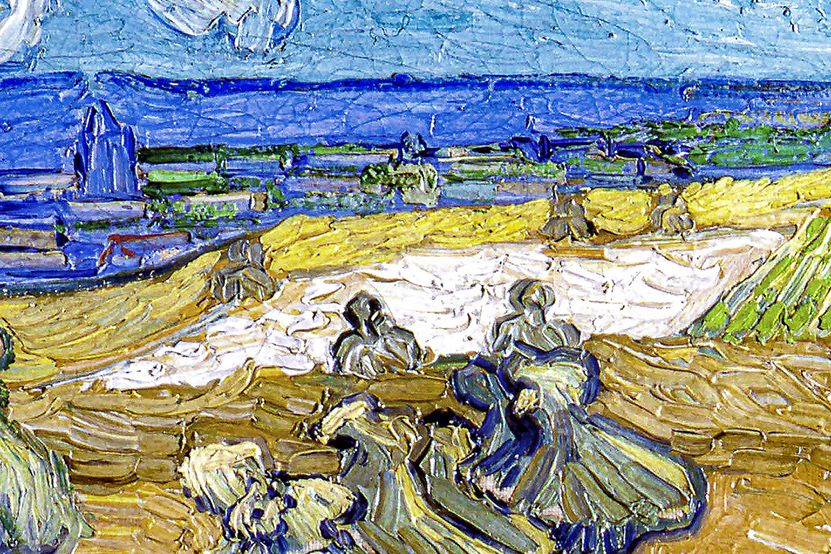 He is escorted by a line of honor in military colors. See the clouds that are descending and impatiently waiting to carry him into heaven. In the upper right sky Vincent painted a "paved road"...... into heaven or towards... only God knows...
He is escorted by a line of honor in military colors. See the clouds that are descending and impatiently waiting to carry him into heaven. In the upper right sky Vincent painted a "paved road"...... into heaven or towards... only God knows...
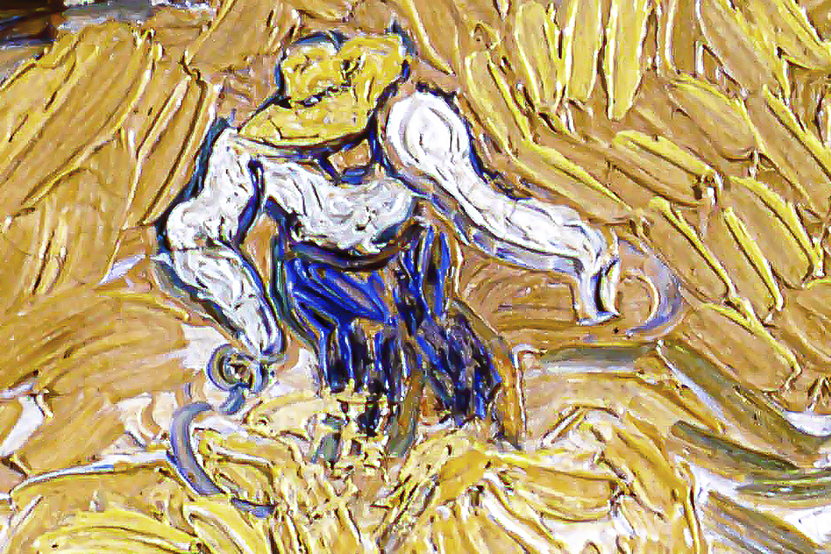 Reaper Vincent has two (2) reaper knives and that is very rare... a farmer normally carries only one reaper knife while working in the field.... So.... this reaper is NOT reaping here.... Vincent is on his way to heaven and death!
Reaper Vincent has two (2) reaper knives and that is very rare... a farmer normally carries only one reaper knife while working in the field.... So.... this reaper is NOT reaping here.... Vincent is on his way to heaven and death!
Thousands have been "seriously studying" the famous painter van Gogh. It appears a bit unbelievable that in all of the 130 years that passed, nobody ever noticed this skull in the trees. We should be proud of our discovery... of... "our skull". Apparently the skull has a low-hanging ear, while some laughing angels are flying around.... This skull is overlooking the very cornfield in front of the castle. Here it should happen... that seemed to be Vincent's plan.
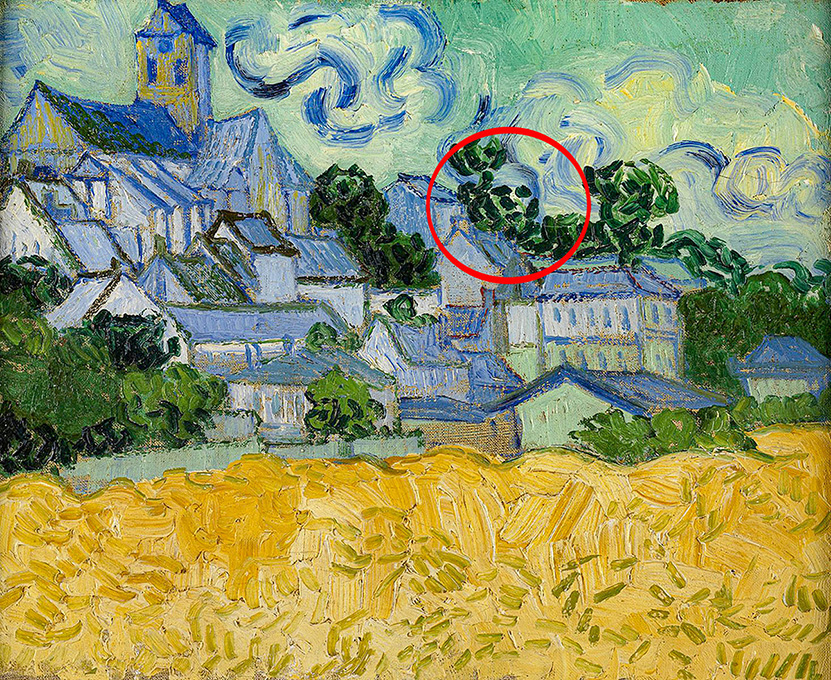 You don't need a lot of imagination to see the skull in the trees.
You don't need a lot of imagination to see the skull in the trees.
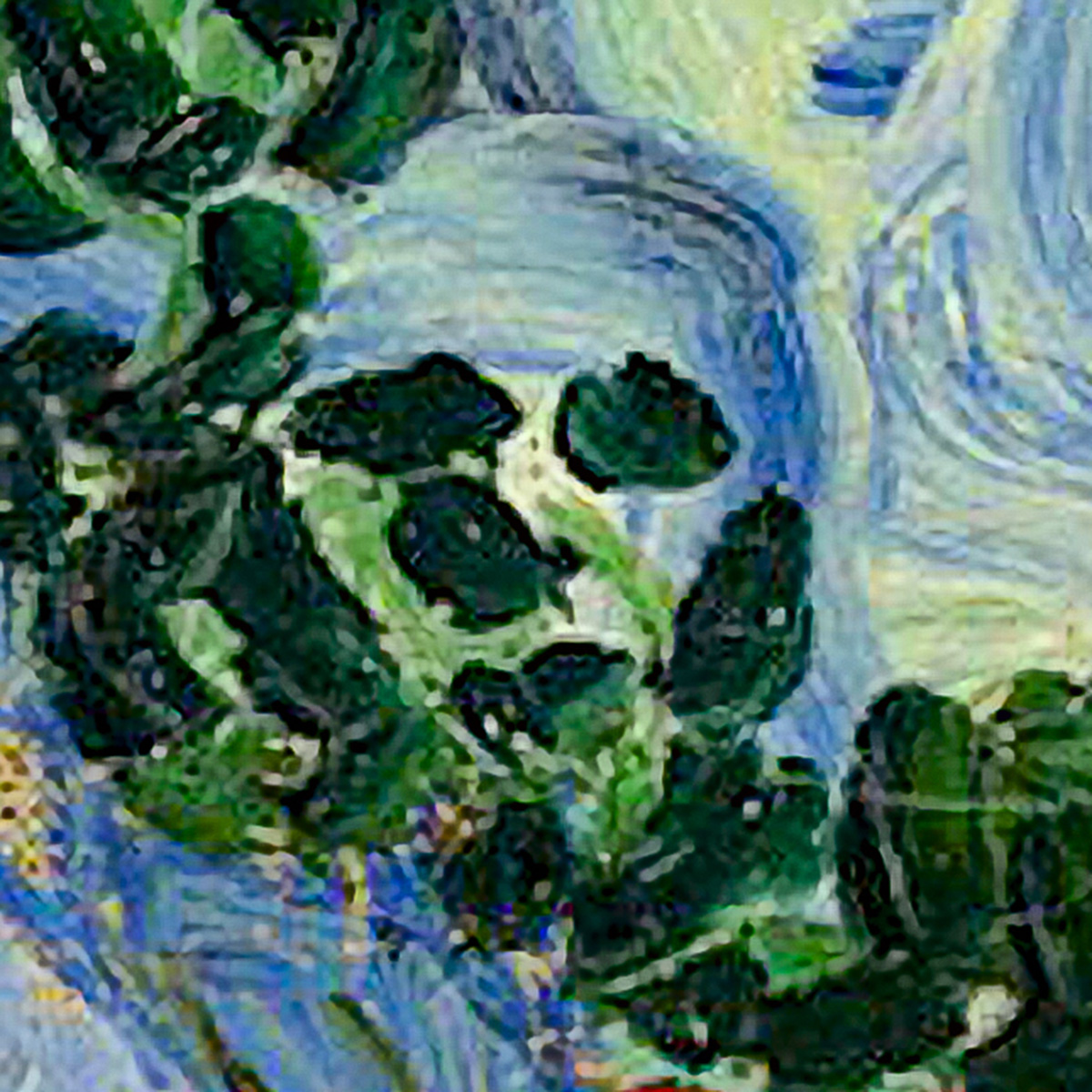 Coincidently for over 130 years nobody did recognize this head of death in these "not-so-random brush strokes" of Vincent. We asked the owner of this painting, a museum in Rhode-Island (USA).... They wrote to us that they never heard of or noticed this.
Coincidently for over 130 years nobody did recognize this head of death in these "not-so-random brush strokes" of Vincent. We asked the owner of this painting, a museum in Rhode-Island (USA).... They wrote to us that they never heard of or noticed this.
And it happened...
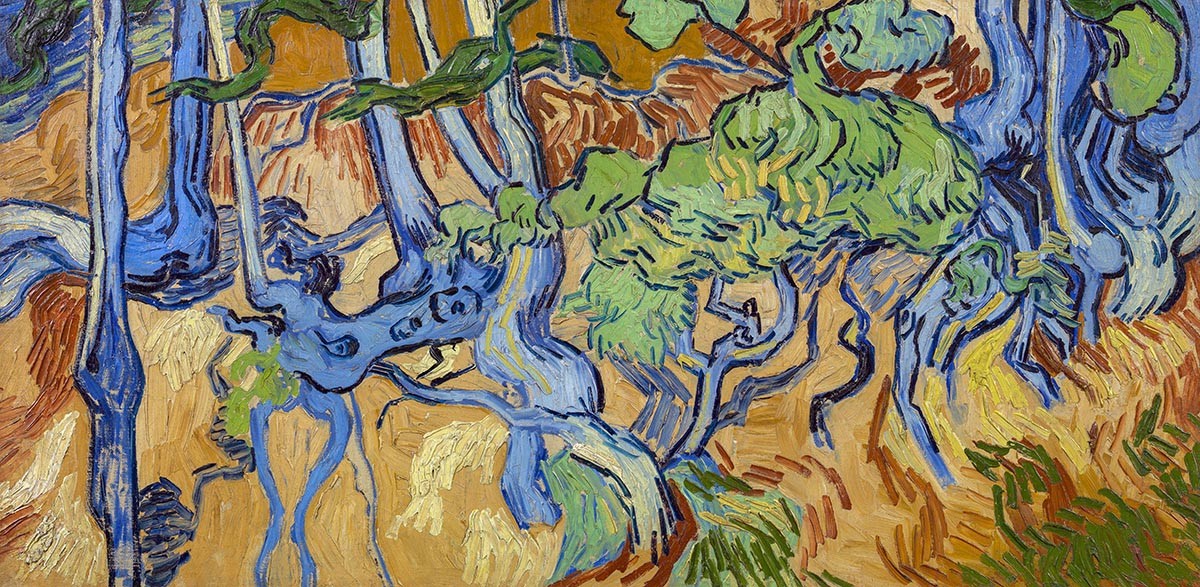
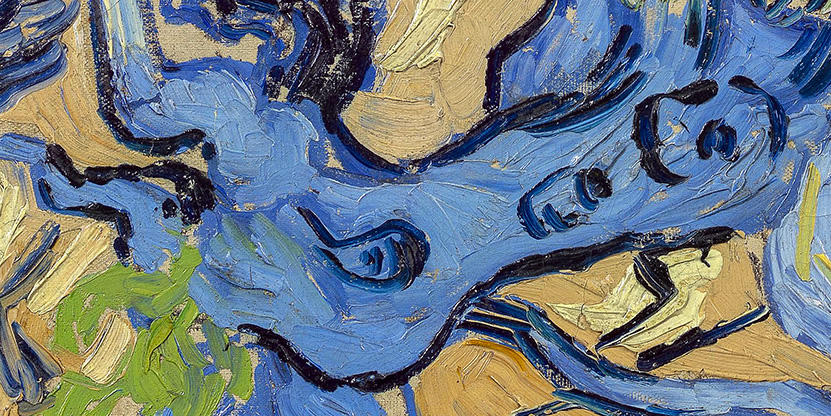
Back to his roots; a few hours after painting this big "TreeRoots" canvas (50x100 cm), he fatally shot himself in his chest and layed himself to rest between his roots, as he showed us in this final painting.
Here below first some more portraits of van Vincent
van Gogh.
Click in each one for a bigger picture....
 |
 |
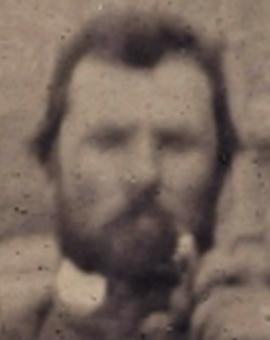 | 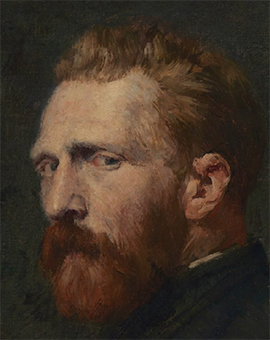 |
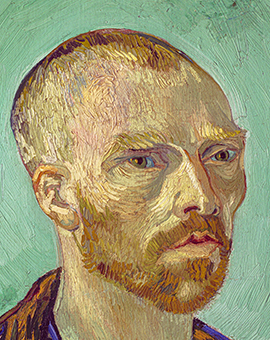 |
 |
 |
 |
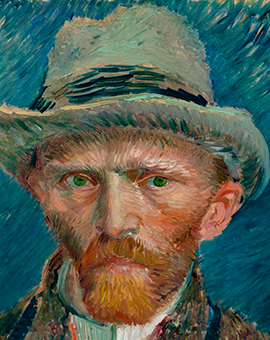 |
 |
 |
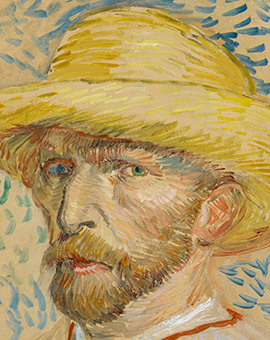 |
 |
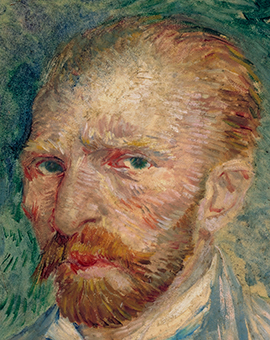 |
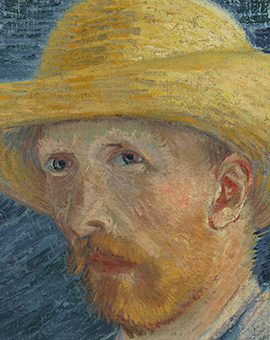 |
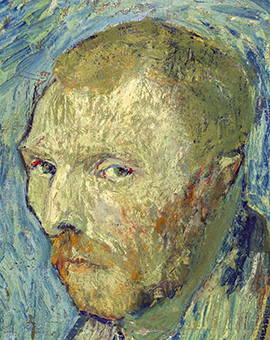 |
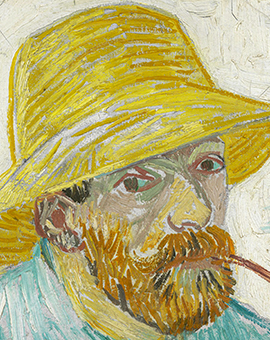 |
 |
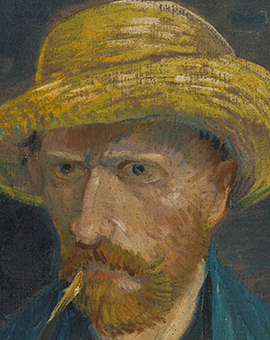 |
 |
Below: one of the most iconic paintings of Vincent: Starry
Night (1889).
Click for a bigger Starry Night



Over the years the death of Vincent has been the subject
of many
fantastic stories, published in books, movies,
publications and websites.
However, in recent years there have been made various new discoveries regarding the last months of his life in the French village Auvers-sur-Oise:
+++The discovery of the gun in 1960.
+++The original location of the painting "TreeRoots" by Wouter van der Veen in 2021 and the statement of the confirmation that TreeRoots was the last painting of van Gogh.
+++Last but not least is our own discoveries in early 2021 of the skull in the trees in the painting "View at Auvers with Church" and the
two reaper knives in van Gogh's painting in the Toledo Museum.
These recent
findings are supporting the latest and "most truthful
representations" of
what happened in June and July 1890 in Auvers-sur-Oise and what led to the death of Vincent van Gogh. Our story is based on the analyses of Vincent's paintings and letters, as well as on publications among others of Van Gogh Museum A'dam,
Martin Bailey, Wouter van der Veen and various publications
on the web. You'll understand that the story of "the murder of Vincent van Gogh" is not viable and realistic anymore after these latest discoveries.
We'll try to avoid dreaming on the cult around van Gogh
and his socalled "famous brusstrokes". He deserves better... there was a lot
of deep understanding in his mindfull decisions... and we will try to penetrate into the mind of this clever and complex personality and we will point at various
details in his paintings that can't be coincidences.
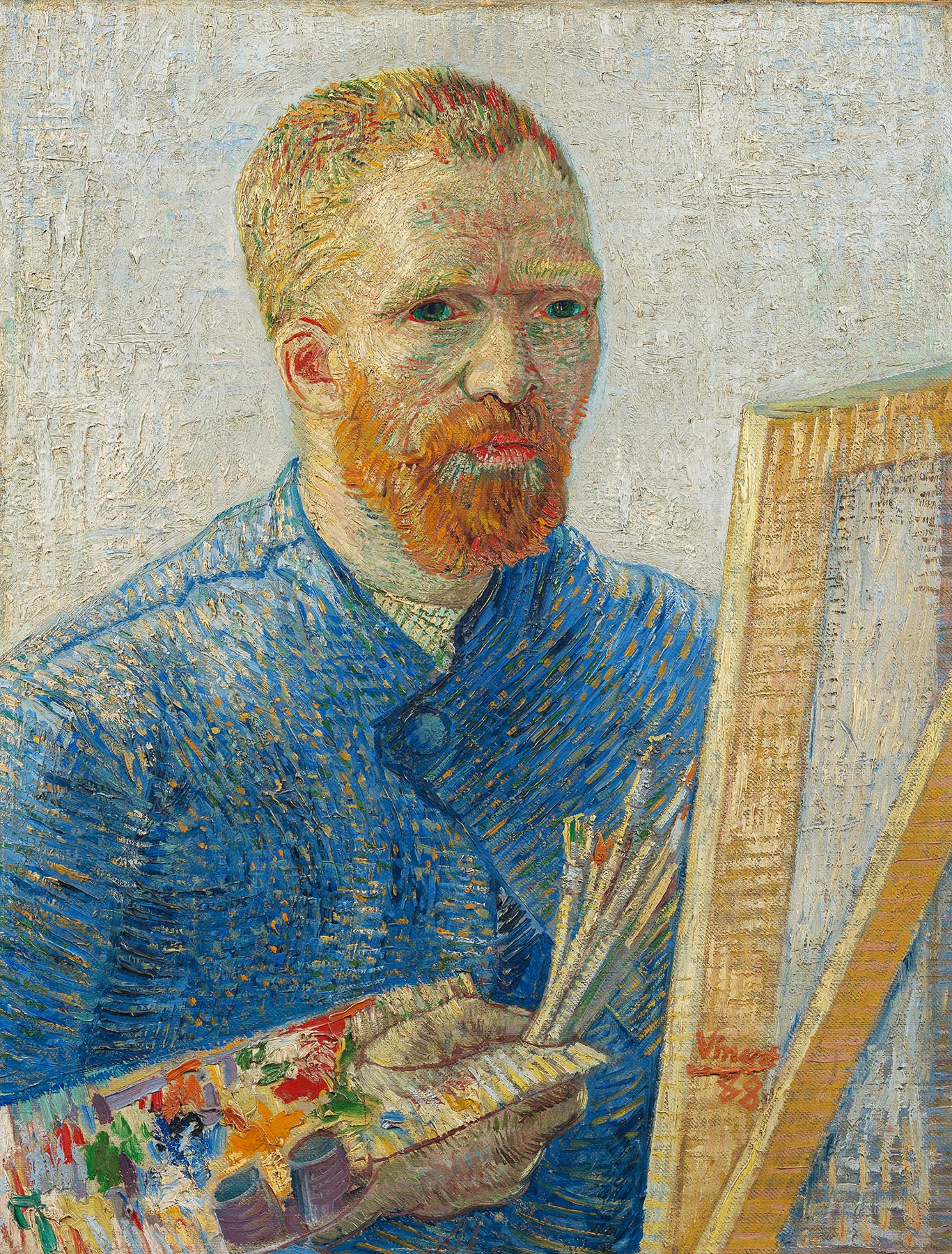 We'll analyze
ten significant
paintings that all were painted in the very weeks before his suicide in
Auvers-sur-Oise. These ten paintings contain hidden secret messages that Vincent was trying to convey.... he was more a painter than a writer.... He wrote to Theo in July:
We'll analyze
ten significant
paintings that all were painted in the very weeks before his suicide in
Auvers-sur-Oise. These ten paintings contain hidden secret messages that Vincent was trying to convey.... he was more a painter than a writer.... He wrote to Theo in July:
"So - having arrived back here, I have set to work again - although the brush is almost falling from my fingers - and because I knew exactly what I wanted to do, I have painted three more large canvases. They are vast stretches of corn under troubled skies, and I did not have to go out of my way very much in order to try to express sadness and extreme loneliness. I hope you will be seeing them soon since I'd like to bring them to you in Paris as soon as possible. I'm fairly sure that these canvases will tell you what I cannot say in words, that is, how healthy and invigorating I find the countryside."
Van Gogh was not deranged. Yes, he had his moments. But his paintings were a product of serious practice and artistic development, because he was extremely sensitive, devoted, and lucid whenever he was well enough to paint.


In May of 1890 the late Dutch painter Vincent van Gogh was
released
from the asylum in Saint Remy (France), where he
"voluntary" but
pressed by his brother Theo, had spent one year and where
he
painted a part of his most famous works like Starry
Night (see above),
Almond
Blossom, the Irisses.  Van Gogh's "terrifying environment" of this french asylum
is revealed
exclusive in a book of Martin Bailey, describing the
harrowing period
in which he produced his most beloved works. The author
and
journalist Martin Bailey, an expert on van Gogh’s life,
traced the
admissions register and other records from Saint-Paul de
Mausole,
a small asylum on the outskirts of Saint-Rémy-de-Provence,
for the
period when Van Gogh was admitted as a private patient, a
stay paid
for by his brother Theo. The register shows Vincent van
Gogh, 36,
from Arles but born in the Netherlands, was admitted on 8
May 1889.
Van Gogh's "terrifying environment" of this french asylum
is revealed
exclusive in a book of Martin Bailey, describing the
harrowing period
in which he produced his most beloved works. The author
and
journalist Martin Bailey, an expert on van Gogh’s life,
traced the
admissions register and other records from Saint-Paul de
Mausole,
a small asylum on the outskirts of Saint-Rémy-de-Provence,
for the
period when Van Gogh was admitted as a private patient, a
stay paid
for by his brother Theo. The register shows Vincent van
Gogh, 36,
from Arles but born in the Netherlands, was admitted on 8
May 1889.
 Through the register, Bailey traced the 18 male patients
including an
elderly priest, Jean Revello, and Henri Enrico, who was
described as
constantly smashing up furniture and crockery. Van Gogh
described
fellow patients, whom he called “my companions in
misfortune”,
slumped into silent resignation, with no treatment and
nothing to fill their
days except the next stodgy meal, eaten with a spoon
because of the
risk from knives and forks. Some, however, were very
troubled. In one
letter, he described the long nights: “One continually
hears shouts and
terrible howls as of animals in a menagerie.”
Through the register, Bailey traced the 18 male patients
including an
elderly priest, Jean Revello, and Henri Enrico, who was
described as
constantly smashing up furniture and crockery. Van Gogh
described
fellow patients, whom he called “my companions in
misfortune”,
slumped into silent resignation, with no treatment and
nothing to fill their
days except the next stodgy meal, eaten with a spoon
because of the
risk from knives and forks. Some, however, were very
troubled. In one
letter, he described the long nights: “One continually
hears shouts and
terrible howls as of animals in a menagerie.” Vincent was judged by his brother and friends to be unfit
to live alone
after he mutilated himself, cutting off his ear
and presenting it, wrapped
in paper, to a young woman in a local brothel, following
the collapse of a
proposed artistic partnership with his companion Paul
Gauguin. The
register was key to discovering previously unknown details
of the artist’s
time there, including the fact that neither his friends
from Arles, 16 miles
(25km) away, nor Theo (his brother and best friend) ever
visited.
Theo van Gogh was kept informed by the stream of
illustrated letters
from his brother, but also news from the asylum director
of van Gogh’s
three serious collapses over the year, when the paints he
tried to
swallow had to be taken from him, and he was confined to a
small, bare,
locked room instead of his usual bright bedroom and
separate studio on
an upper floor. The director of the asylum, Théophile
Peyron, wrote:
“On several occasions he has attempted to poison himself,
either by
swallowing colours that he used for painting, or by
ingesting paraffin,
which he had taken from the boy while he was filling his
lamps.
” His brother, recently married and expecting his first
child in Paris,
stayed away. Bailey wrote: “I now appreciate quite what a
terrifying
environment it must have been for van Gogh."
“That makes it even more astonishing that he was able to
create some of
his finest and [most] optimistic paintings in such a
situation. I am also
convinced that it was his art which enabled him to
survive.”
Vincent was released on 16 May 1890, at his own request,
despite
evidence of mental collapse following his previous brief
breaks from the
asylum. He yearned for new spring landscapes to paint,
blamed the
company of his fellow patients for his previous and
longest collapse, and wrote “the prison was crushing me”. Here below first a
letter, written by Theo's wife Jo a few weeks
before Vincent is leaving the asylum...
Vincent was judged by his brother and friends to be unfit
to live alone
after he mutilated himself, cutting off his ear
and presenting it, wrapped
in paper, to a young woman in a local brothel, following
the collapse of a
proposed artistic partnership with his companion Paul
Gauguin. The
register was key to discovering previously unknown details
of the artist’s
time there, including the fact that neither his friends
from Arles, 16 miles
(25km) away, nor Theo (his brother and best friend) ever
visited.
Theo van Gogh was kept informed by the stream of
illustrated letters
from his brother, but also news from the asylum director
of van Gogh’s
three serious collapses over the year, when the paints he
tried to
swallow had to be taken from him, and he was confined to a
small, bare,
locked room instead of his usual bright bedroom and
separate studio on
an upper floor. The director of the asylum, Théophile
Peyron, wrote:
“On several occasions he has attempted to poison himself,
either by
swallowing colours that he used for painting, or by
ingesting paraffin,
which he had taken from the boy while he was filling his
lamps.
” His brother, recently married and expecting his first
child in Paris,
stayed away. Bailey wrote: “I now appreciate quite what a
terrifying
environment it must have been for van Gogh."
“That makes it even more astonishing that he was able to
create some of
his finest and [most] optimistic paintings in such a
situation. I am also
convinced that it was his art which enabled him to
survive.”
Vincent was released on 16 May 1890, at his own request,
despite
evidence of mental collapse following his previous brief
breaks from the
asylum. He yearned for new spring landscapes to paint,
blamed the
company of his fellow patients for his previous and
longest collapse, and wrote “the prison was crushing me”. Here below first a
letter, written by Theo's wife Jo a few weeks
before Vincent is leaving the asylum...

Vincent moved via Paris, where his brother Theo was living
with
his family, to the small village of Auvers-sur-Oise, 25
kilometers
more to the north in France. He had hoped to find peace of
mind here and he had hoped to be able to continue his work
as
an art-painter.
However, all went different in Auvers as our dear Vincent
had
too many personal problems.
To mention a few:
- Vincent permanently felt the threat of losing the
essential and vital financial support of his brother Theo.
Vincent understood that his brother had advanced syphilis while Theo
just got married, he had a babyboy and wanted to start his own
art-business with all financial uncertenties. Vincent could become a
burden...
- Vincent was aware of his own very bad health as a result
of his yearslong syphilis as well as and working with (and
sometimes eating) the poisonous paints and drinking
turpentine, while trying to end his life on various occasions in the recent
past. He was
as well worried that his glaucoma would result in
blindness...
- He suffered from an extreme loneliness as his difficult
character pushed away any possible friend, companion or
lover, while he needed so badly whomever at his side... He often
felt socially rejected by persons around him.... he was extremely
insecure.
- Vincent didn't have a clear straigthforward contact with
the persons around him.... he had different
personality-presentations for each individual around him..... he was a
typical vague guy from Brabant, the south of the Netherlands.
An example of this caracter may be seen in the following
letter that
Vincent wrote to his sister in June 1890.... while he was
entering the
utmost crisis of his life and living towards his
suicide.... He wrote this
very calm and non-alarming letter in which all seemed to
be all-right:
a simple letter, proving that Vincent was far from the
madman that
many people believe he was.... He just had his ups and downs....
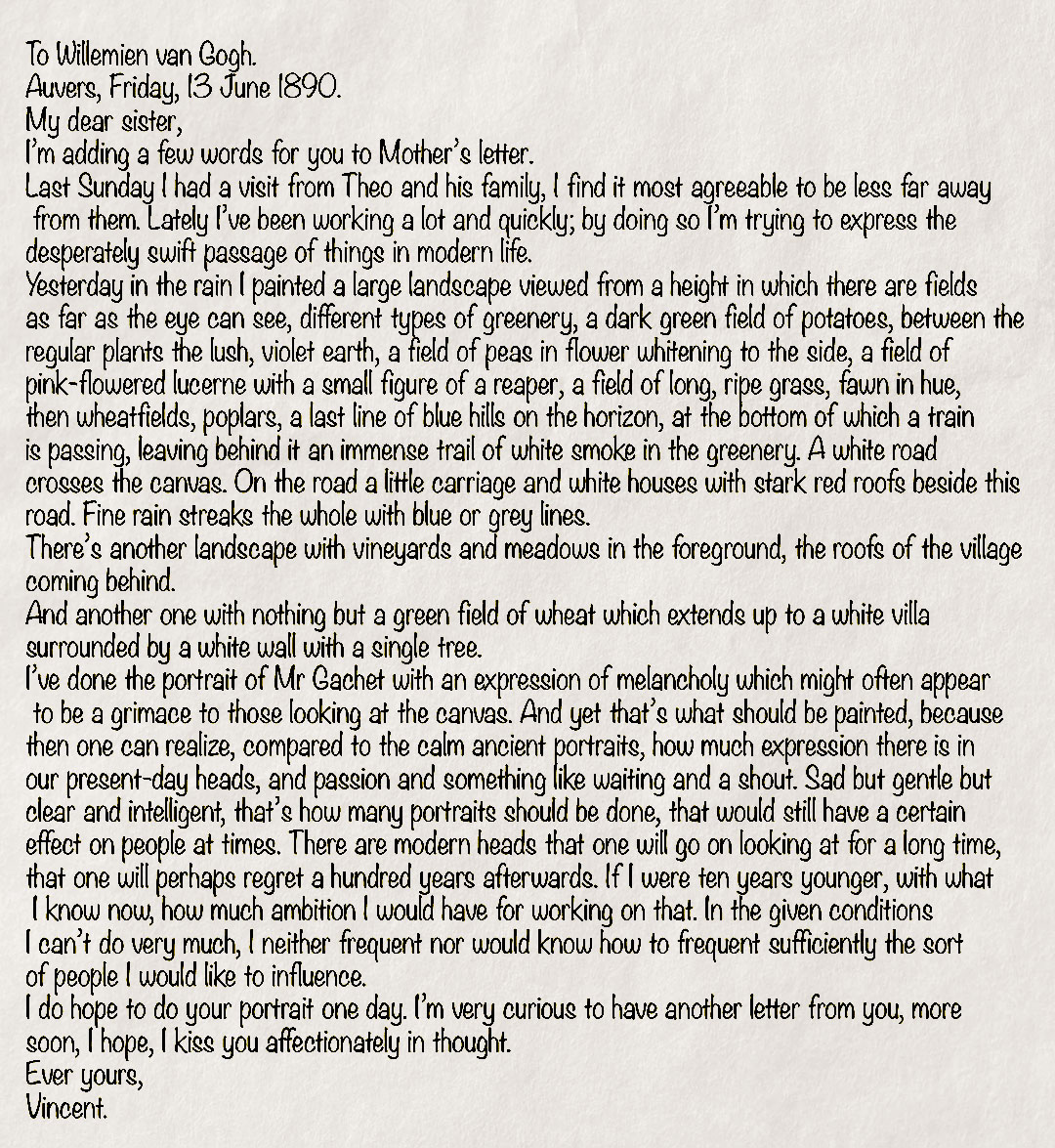 Vincents ability to paint beautiful art depended on his state of mind
and his social tranquility. In the asylum in Saint Remy,
separated from
social disturbancies, van Gogh made his best works. However, now in Auvers, there were lots of derailing influences that he had to
overcome to reach an acceptable artistic level... In Arles he had had the strong hope of having his
"illusion Studio of the South" while he had the girls
in this big town... Than came Paul Gauguin with the disasterous
outcome as this guy was an egocentric artist and not a suitable
socially caring person that Vincent needed. After only two months this resulted in a
cut-off ear and Vincent going to an asylum. Vincent stayed a full year in Saint-Paul Asylum in Saint-Rémy de
Provence where his social force didn't improve while he appeared
to recover from the mental blow of the departure of
Gauguin.
Anyway he left Saint Rémy in May 1890 but the entry into the real
world
after one year in relative isolation turned
out to be
far too overwhelming for this over-sensitive vulnerable
creature....
In Paris he was happy to see Theo's son Vincent for the
first time.
However, the social intensity in Paris got, after only two
days, too much to bear and he had an early escape from Paris to
Auvers-sur-Oise, where he was planned to stay "under guidance" of
Paul Gachet, a homeopathic doctor and art-collectioner. Gachet, himself a
complex and busy personality, never digged deep into the
psyche of Vincent nor gave him any relaxing herbs...
Gachet put him up to
simply paint. Vincent anyway felt some kind of help and friendship
while he was trying to find an equilibrium in his mind while painting some
surprisingly good paintings. The overall tendency was sadness and loneliness but nobody noticed Vincent's alarms and
his hope for the better was rapidly fading away. His mood
could change rapidly up and down.. Vincent could analyse his
situation with
logic and he could put it all together: the
disappointments, the treaths,
the sufferings, the loneliness.... He made his conclusions
all by
himself alone and in complete lucidety...
Seriously and secretly he started preparing his
"departure from life", looking
for a suitable place to terminate this torture: maybe
behind the castle,
maybe just in his beloved wheatfield....
Never had he felt the urge "to leave this life" so strongly. Yes, in the early years he would eat paint and drink turpentine to
attract attention.
But this time it was different.... he was getting convinced about "his
departure". He started to paint secretly hidden hints to his problems and even to "death"..
Vincents ability to paint beautiful art depended on his state of mind
and his social tranquility. In the asylum in Saint Remy,
separated from
social disturbancies, van Gogh made his best works. However, now in Auvers, there were lots of derailing influences that he had to
overcome to reach an acceptable artistic level... In Arles he had had the strong hope of having his
"illusion Studio of the South" while he had the girls
in this big town... Than came Paul Gauguin with the disasterous
outcome as this guy was an egocentric artist and not a suitable
socially caring person that Vincent needed. After only two months this resulted in a
cut-off ear and Vincent going to an asylum. Vincent stayed a full year in Saint-Paul Asylum in Saint-Rémy de
Provence where his social force didn't improve while he appeared
to recover from the mental blow of the departure of
Gauguin.
Anyway he left Saint Rémy in May 1890 but the entry into the real
world
after one year in relative isolation turned
out to be
far too overwhelming for this over-sensitive vulnerable
creature....
In Paris he was happy to see Theo's son Vincent for the
first time.
However, the social intensity in Paris got, after only two
days, too much to bear and he had an early escape from Paris to
Auvers-sur-Oise, where he was planned to stay "under guidance" of
Paul Gachet, a homeopathic doctor and art-collectioner. Gachet, himself a
complex and busy personality, never digged deep into the
psyche of Vincent nor gave him any relaxing herbs...
Gachet put him up to
simply paint. Vincent anyway felt some kind of help and friendship
while he was trying to find an equilibrium in his mind while painting some
surprisingly good paintings. The overall tendency was sadness and loneliness but nobody noticed Vincent's alarms and
his hope for the better was rapidly fading away. His mood
could change rapidly up and down.. Vincent could analyse his
situation with
logic and he could put it all together: the
disappointments, the treaths,
the sufferings, the loneliness.... He made his conclusions
all by
himself alone and in complete lucidety...
Seriously and secretly he started preparing his
"departure from life", looking
for a suitable place to terminate this torture: maybe
behind the castle,
maybe just in his beloved wheatfield....
Never had he felt the urge "to leave this life" so strongly. Yes, in the early years he would eat paint and drink turpentine to
attract attention.
But this time it was different.... he was getting convinced about "his
departure". He started to paint secretly hidden hints to his problems and even to "death"..
Ten indicative paintings |
He painted these harbingers in the two months before his suicide and one can see the development of Vincent's sad and lonely mind into a suicidal state, resulting in the last painting here below: "TreeRoots" is his final suicide note. On that fatal day and after he almost terminated this big canvas, Vincent walked into the field and shot himself... Here below the sequence from worrying to finally deadly....
#1
|
In mid-June 1890, Auvers, Vincent painted "The White House"... a frigthening house of witches and strange windows. Was it a brothel maybe? The only words Vincent wrote to Theo were: "The second study, a white house in the verdure with a star in the night sky and an orange-coloured light in the window and black verdure and a note of sombre pink."
 "The State Hermitage Museum, Saint Petersburg/Russia
writes on www:
In May 1890, Vincent van Gogh came to Auvers-sur-Oise and
painted
a series of pictures with houses. The Auvers period began
with the hope
of a new life and the recovery of health. This sense of
hope was
expressed in the pictures executed in May. In the June
paintings, the
motif of the home remained at the centre of the artist's
attention, but
its emotional range expanded greatly - from gloomy
foreboding to
conciliation. Since the emotion was expressed by the
artist not through
the subject itself, but through his manipulation of the
methods of
painting, the structure of his compositions changed each
time. In the
present picture a frozen quality prevails, and the chief
lines are stable
horizontals and verticals. They are needed to draw a
house, but they
can turn it into a prison. The artist gives much attention
to windows,
the "eyes" of a home. The red splashes of the windows to
the right are
alarming; van Gogh would draw a star, a sign of fate, at
moments of
greatest anguish. The White House at Night expresses the
great
psychological tension under which Van Gogh found himself.
"The State Hermitage Museum, Saint Petersburg/Russia
writes on www:
In May 1890, Vincent van Gogh came to Auvers-sur-Oise and
painted
a series of pictures with houses. The Auvers period began
with the hope
of a new life and the recovery of health. This sense of
hope was
expressed in the pictures executed in May. In the June
paintings, the
motif of the home remained at the centre of the artist's
attention, but
its emotional range expanded greatly - from gloomy
foreboding to
conciliation. Since the emotion was expressed by the
artist not through
the subject itself, but through his manipulation of the
methods of
painting, the structure of his compositions changed each
time. In the
present picture a frozen quality prevails, and the chief
lines are stable
horizontals and verticals. They are needed to draw a
house, but they
can turn it into a prison. The artist gives much attention
to windows,
the "eyes" of a home. The red splashes of the windows to
the right are
alarming; van Gogh would draw a star, a sign of fate, at
moments of
greatest anguish. The White House at Night expresses the
great
psychological tension under which Van Gogh found himself.
#2 |
As well in June 1890 Vincent painted "Twilight behind the
castle", a 100x50cm
work showing an area of Auvers where he would execute his
suicide a month later.... He was exploring Auvers in search for a
good suicide location.
He didn't tell not even his brother Theo... Only he wrote
him in a letter:
“An evening effect—two completely dark pear trees against
yellowing sky with
wheatfields, and in the violet background the château
encased in the somber
dark greenery.”

Here the comment on the website of van Gogh Museum
Amsterdam mentioning
"brushstrokes" and ignoring the stress of the painter
being here behind the castle
and planning his suicide. Quote of the museum
website: "Van Gogh made this
evening landscape in the fields near Auvers, with a view
of the local castle.
He rendered the tangled black branches of the pear trees
with a flurry of black
brushstrokes. This reinforces the contrast between the
dark trees and the
luminous yellow sky."
Martin Bailey in Finale: "But what gives the
picture its impact is the luminous,
golden evening sky. Van Gogh was aiming not for realism,
but for dramatic
effect. Landscape
at Twilight has a particular resonance in the van
Gogh story,
since Vincent shot himself on the edge of a wheatfield
that layed just beyond the
far side of the château. In the early evening of 27 July
1890, when he set off
for his last journey, he probably walked along the very
path that appears in this
painting. But for once, it was not art that was on his
mind—his agonising
thoughts were on the impending end."
#3
|
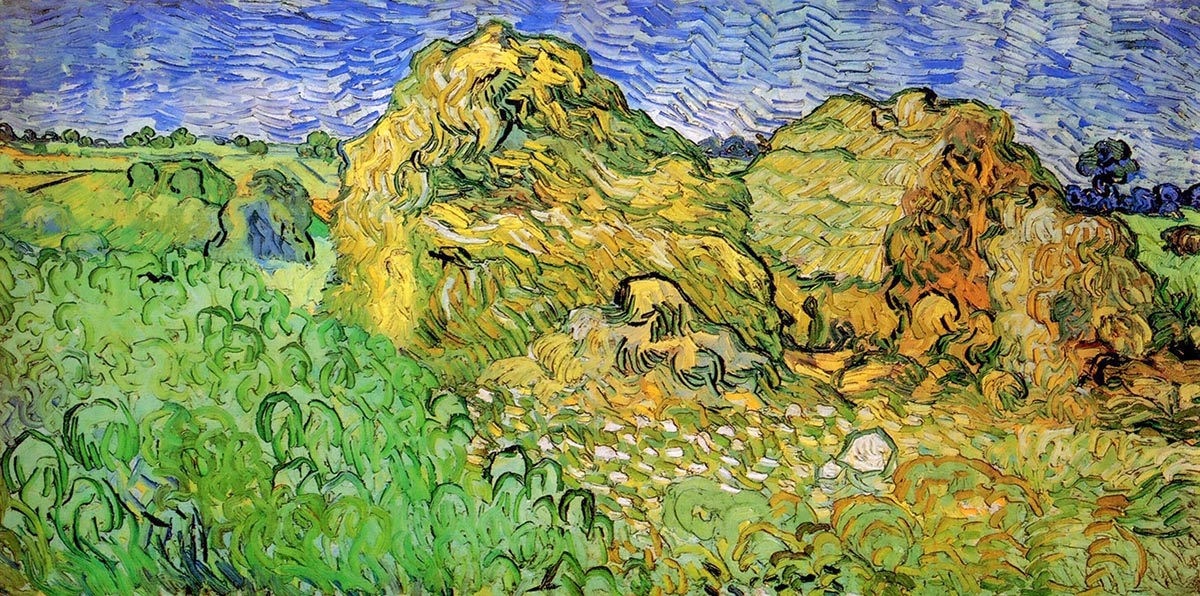 Considered one of van Gogh’s very last paintings, Field
with Stacks of Wheat is
both more rigid and at the same time more abstract than
Wheatfield with
cornflowers. Divided into fields of varying rhythmical
structure, the brushstrokes
here overlie the landscape like a grid. The picture
culminates in the two large
stacks of wheat that tower over the empty plateau like
abandoned dwellings and
thereby almost completely cut off the sky. The only living
creature is a solitary
crow, flying into the depths of the landscape on the left.
Considered one of van Gogh’s very last paintings, Field
with Stacks of Wheat is
both more rigid and at the same time more abstract than
Wheatfield with
cornflowers. Divided into fields of varying rhythmical
structure, the brushstrokes
here overlie the landscape like a grid. The picture
culminates in the two large
stacks of wheat that tower over the empty plateau like
abandoned dwellings and
thereby almost completely cut off the sky. The only living
creature is a solitary
crow, flying into the depths of the landscape on the left.
#4
|
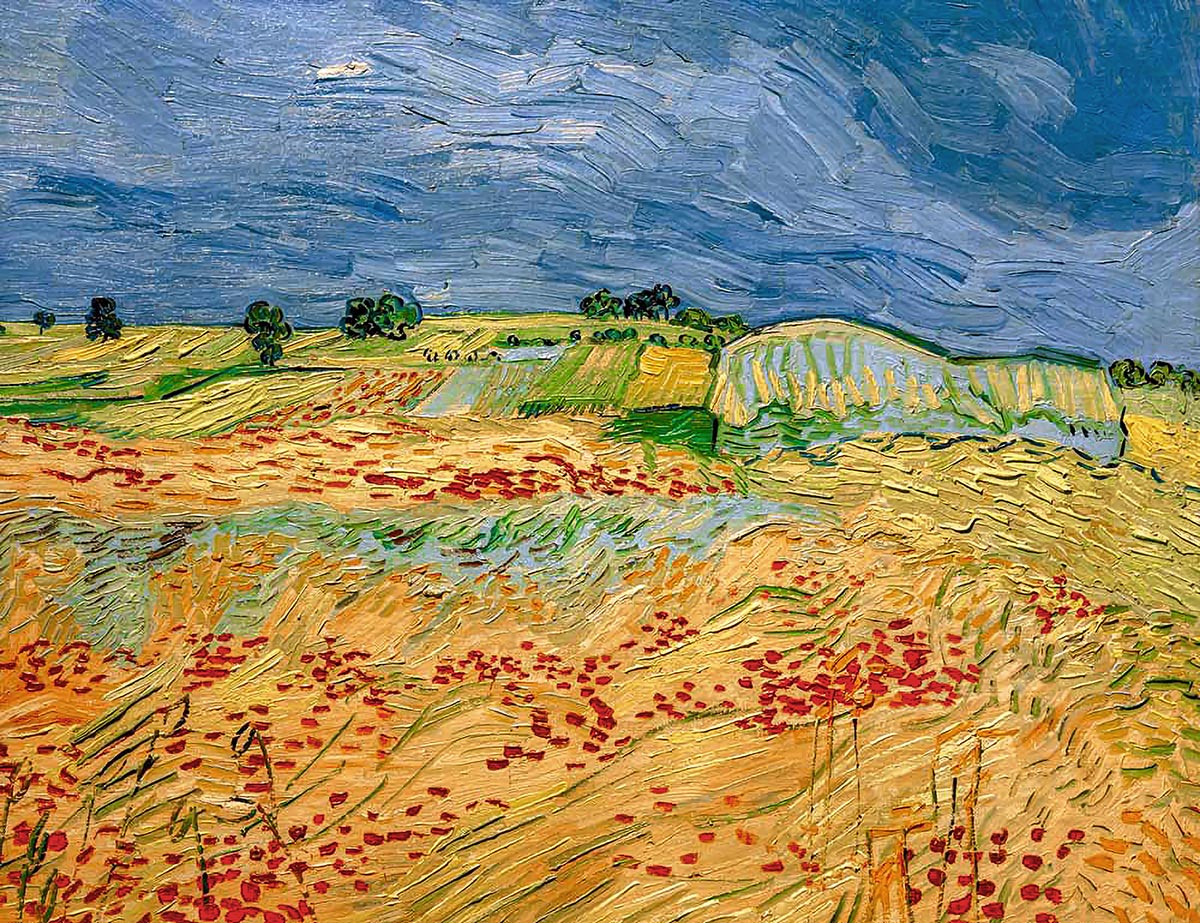 The area surrounding Auvers afforded van Gogh plenty of
scenery for inspiration,
and during his last months, the artist painted numerous
scenes of wheat fields
and wide-open, windy countryside. The sky here has an
oppressive weight, and
seems to bear down on the vast expanse of land, while both
the sky and the
land have been pointed with on undulating rhythm that
suggests great movement
the picture has an uneasiness, which is compounded by
peculiar perspective.
The field delineated to the right of the picture appears
to jump forward, while
those to the left that should be on the same rush
backwards, and there is a
spatial ambiguity between the area of poppies in the
foreground and the fields
in the distance. The whole presents a turbulent image that
is unsettling and
unconvincing. The painting was done in the weeks prior to
him taking his own
life, and at a time when his world was falling in. He was
extremely anxious
about his brother Theo and his family, and had fallen out
with Dr Gachet -
he felt alone and ultimately unable to cope.
The area surrounding Auvers afforded van Gogh plenty of
scenery for inspiration,
and during his last months, the artist painted numerous
scenes of wheat fields
and wide-open, windy countryside. The sky here has an
oppressive weight, and
seems to bear down on the vast expanse of land, while both
the sky and the
land have been pointed with on undulating rhythm that
suggests great movement
the picture has an uneasiness, which is compounded by
peculiar perspective.
The field delineated to the right of the picture appears
to jump forward, while
those to the left that should be on the same rush
backwards, and there is a
spatial ambiguity between the area of poppies in the
foreground and the fields
in the distance. The whole presents a turbulent image that
is unsettling and
unconvincing. The painting was done in the weeks prior to
him taking his own
life, and at a time when his world was falling in. He was
extremely anxious
about his brother Theo and his family, and had fallen out
with Dr Gachet -
he felt alone and ultimately unable to cope.
#5 |
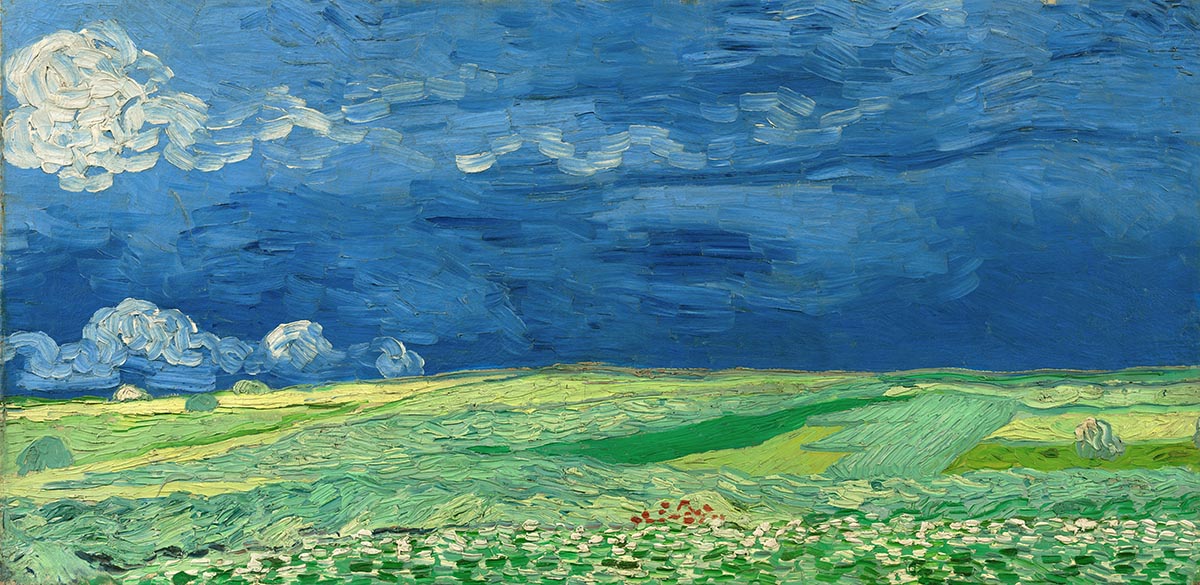 In van Gogh's "Wheatfields Under
Thunderclouds" (also called Wheat Fields
Under
Clouded Sky he depicts the loneliness of the
countryside and the degree to
which it was "healthy and heartening."
Oil on canvas, 50.4 cm x 101.3 cm. In the last weeks of
his life, van Gogh
completed a number of impressive paintings of the
wheatfields around Auvers.
This outspread field under a dark sky is one of them. In
these landscapes he
tried to express 'sadness and extreme loneliness'. But the
overwhelming emotions
that van Gogh experienced in nature were also positive. He
wrote to his brother
Theo, "I'd almost believe that these canvases will tell
you what I can't say in
words, what I consider healthy and fortifying about the
countryside."
The elongated format of Wheatfields under
Thunderclouds is unusual. It
emphasizes the grandeur of the landscape, as does the
simple composition:
two horizontal planes.
In van Gogh's "Wheatfields Under
Thunderclouds" (also called Wheat Fields
Under
Clouded Sky he depicts the loneliness of the
countryside and the degree to
which it was "healthy and heartening."
Oil on canvas, 50.4 cm x 101.3 cm. In the last weeks of
his life, van Gogh
completed a number of impressive paintings of the
wheatfields around Auvers.
This outspread field under a dark sky is one of them. In
these landscapes he
tried to express 'sadness and extreme loneliness'. But the
overwhelming emotions
that van Gogh experienced in nature were also positive. He
wrote to his brother
Theo, "I'd almost believe that these canvases will tell
you what I can't say in
words, what I consider healthy and fortifying about the
countryside."
The elongated format of Wheatfields under
Thunderclouds is unusual. It
emphasizes the grandeur of the landscape, as does the
simple composition:
two horizontal planes.
#6
|
 The Wheatfield with Crows was made in July 1890, in the
last weeks of Van Gogh's life and many have claimed
it was his last work.
Van Gogh Museum A'dam, the ultimate authority, declared
Tree-Roots was
his last painting. Wheatfield with Crows, made on
an elongated canvas, depicts a
dramatic cloudy sky filled with crows over a wheat field.
The wind-swept wheat
field fills two thirds of the canvas. An empty path pulls
the audience into the
painting. Of making the painting van Gogh wrote that he
did not have a hard
time depicting the sadness and emptiness of the painting,
which was powerfully
offset by the restorative nature of the countryside. Ericson, cautious of attributing stylistic changes in his work to mental illness, finds the painting expresses both the sorrow and the sense of his life coming to an end.
The crows, used by van Gogh as symbol of death and rebirth
or resurrection,
visually draw the spectator into the painting.
The Wheatfield with Crows was made in July 1890, in the
last weeks of Van Gogh's life and many have claimed
it was his last work.
Van Gogh Museum A'dam, the ultimate authority, declared
Tree-Roots was
his last painting. Wheatfield with Crows, made on
an elongated canvas, depicts a
dramatic cloudy sky filled with crows over a wheat field.
The wind-swept wheat
field fills two thirds of the canvas. An empty path pulls
the audience into the
painting. Of making the painting van Gogh wrote that he
did not have a hard
time depicting the sadness and emptiness of the painting,
which was powerfully
offset by the restorative nature of the countryside. Ericson, cautious of attributing stylistic changes in his work to mental illness, finds the painting expresses both the sorrow and the sense of his life coming to an end.
The crows, used by van Gogh as symbol of death and rebirth
or resurrection,
visually draw the spectator into the painting.
#7 |
Contradicting the interpretation of Museum Toledo here
below, we believe that
we see a reaper with two (2) reaping-hooks in both of his
hands. It seems to
be Vincent on his way to heaven with in the distance a rare white field and the clouds in the sky waiting to take him up to heaven. In the field we see a guard of honor on both sides of the lane escorting Vincent in
military colors.
 Toledo Museum of Art in USA just writes on their web-site:
"Vincent van Gogh was fascinated by the vast fields of wheat that stretched above Auvers-sur-Oise, a town north of Paris where he lived the last two months of his life. He painted many views of these fields,
including this landscape with a reaper cutting the golden grain while the stacked sheaves recede toward a village and the distant blue hills. For van Gogh, the reaper was sometimes a biblical metaphor of the final harvest when mankind will be reaped like ripe wheat. “But,” he wrote to his brother Theo in 1889,
“there’s nothing sad in this death, it goes its way in broad daylight with a sun
flooding everything with a light of pure gold… It is an image of death as the great
book of nature speaks
of it.”
Though inspired by the observation of his immediate surroundings, van Gogh
was not interested in mimicking what he saw. As he wrote in 1888 to Theo: “Instead of trying to reproduce exactly what I have before my eyes, I use
color more arbitrarily, to express myself more
forcibly." His thick, sculptural brushstrokes add to this forceful expression.
Toledo Museum of Art in USA just writes on their web-site:
"Vincent van Gogh was fascinated by the vast fields of wheat that stretched above Auvers-sur-Oise, a town north of Paris where he lived the last two months of his life. He painted many views of these fields,
including this landscape with a reaper cutting the golden grain while the stacked sheaves recede toward a village and the distant blue hills. For van Gogh, the reaper was sometimes a biblical metaphor of the final harvest when mankind will be reaped like ripe wheat. “But,” he wrote to his brother Theo in 1889,
“there’s nothing sad in this death, it goes its way in broad daylight with a sun
flooding everything with a light of pure gold… It is an image of death as the great
book of nature speaks
of it.”
Though inspired by the observation of his immediate surroundings, van Gogh
was not interested in mimicking what he saw. As he wrote in 1888 to Theo: “Instead of trying to reproduce exactly what I have before my eyes, I use
color more arbitrarily, to express myself more
forcibly." His thick, sculptural brushstrokes add to this forceful expression.
#8 |
Here we see a death-head overlooking the very field where
Vincent would
shoot himself in the chest in the early evening of the
27th July 1890.
 Early 2021 we discovered a never noticed hidden
deaths-head by Vincent van
Gogh, while for over 130 years "hidden" in the trees. Around June 2021 we informed Van Gogh Museum A'dam about our finding, and
haven't heard back
from them yet. Vincent painted this skull just before his suicide in a painting that was long time
thought to be a "fake-vanGogh". The painting was downgraded in the 1970s, banished to the stores, dismissed as “a pastiche by an
unknown hand”. But
research by the Van Gogh Museum, the ultimate referee,
confirmed its
authenticity in 2016. Our skull is overlooking the very
wheatfield where the
shooting would happen a few weeks later. Neither scholars
of van Gogh
Museum A'dam nor the owners of the painting, the Rhode
Island Museum,
ever mentioned these skull-like brushstrokes. RSID wrote to us that they
have never published anything about these "skull-like
brush-strokes".
My opinion: "This skull is the only direct hint to his "death"
that Vincent painted in the last
years of his life." Vincent must have been surprised of
himself, painting this
first strong explicit hint to death. He must have been more and more convinced of his suicide about two weeks before
execution... He was
from the south of the Netherlands and a champion in vague
hints.... and
there were plenty in his paintings and in his letters: the
hundreds of black
crows, lots of reapers, the black cat, the rainy
landscapes, and all
Vincent's expressions of loneliness, sadness, feelings of
failure and
"the need to end his life".
However.... this death-head was very direct!!!
Early 2021 we discovered a never noticed hidden
deaths-head by Vincent van
Gogh, while for over 130 years "hidden" in the trees. Around June 2021 we informed Van Gogh Museum A'dam about our finding, and
haven't heard back
from them yet. Vincent painted this skull just before his suicide in a painting that was long time
thought to be a "fake-vanGogh". The painting was downgraded in the 1970s, banished to the stores, dismissed as “a pastiche by an
unknown hand”. But
research by the Van Gogh Museum, the ultimate referee,
confirmed its
authenticity in 2016. Our skull is overlooking the very
wheatfield where the
shooting would happen a few weeks later. Neither scholars
of van Gogh
Museum A'dam nor the owners of the painting, the Rhode
Island Museum,
ever mentioned these skull-like brushstrokes. RSID wrote to us that they
have never published anything about these "skull-like
brush-strokes".
My opinion: "This skull is the only direct hint to his "death"
that Vincent painted in the last
years of his life." Vincent must have been surprised of
himself, painting this
first strong explicit hint to death. He must have been more and more convinced of his suicide about two weeks before
execution... He was
from the south of the Netherlands and a champion in vague
hints.... and
there were plenty in his paintings and in his letters: the
hundreds of black
crows, lots of reapers, the black cat, the rainy
landscapes, and all
Vincent's expressions of loneliness, sadness, feelings of
failure and
"the need to end his life".
However.... this death-head was very direct!!!
#9 |
 Emotional turmoil
Illness had struck Theo's baby, Vincent and Theo had
health problems and
employment issues. Theo was considering leaving his
employer to start his own
business. Gachet, said to have his own eccentricities
and neurosis, caused van
Gogh to write: "Now when one blind man leads another
blind man, don't they
both end up in the ditch?" After visiting Paris for a
family conference, van Gogh
returned to Auvers feeling more bleak. In a letter he
wrote, "And the prospect
grows darker, I see no future at all."
He later had a period where he said that "the trouble I
had in my head has
considerably calmed... I am completely absorbed in that
immense plain
covered with fields of wheat against the hills boundless
as the sea in delicate
colors of yellow and green, the pale violet of the
plowed and weeded earth
checkered at regular intervals with the green of the
flowering potato plants,
everything under a sky of delicate blue, white, pink,
and violet. I am almost
too calm, a state that is necessary to paint all that."
Emotional turmoil
Illness had struck Theo's baby, Vincent and Theo had
health problems and
employment issues. Theo was considering leaving his
employer to start his own
business. Gachet, said to have his own eccentricities
and neurosis, caused van
Gogh to write: "Now when one blind man leads another
blind man, don't they
both end up in the ditch?" After visiting Paris for a
family conference, van Gogh
returned to Auvers feeling more bleak. In a letter he
wrote, "And the prospect
grows darker, I see no future at all."
He later had a period where he said that "the trouble I
had in my head has
considerably calmed... I am completely absorbed in that
immense plain
covered with fields of wheat against the hills boundless
as the sea in delicate
colors of yellow and green, the pale violet of the
plowed and weeded earth
checkered at regular intervals with the green of the
flowering potato plants,
everything under a sky of delicate blue, white, pink,
and violet. I am almost
too calm, a state that is necessary to paint all that."
Four days after completing Wheat Fields after the
Rain he shot himself in
the Auvers wheat fields. Van Gogh died on July 29, 1890.
#10 |
Did the suicidal genius Vincent paint his own dead body laying between treeroots. We believe so... His suicide-plan must have been all the time (un)concious in his alert mind that day and his prefered and chosen field of execution was nearby and almost next to the location of the treeroots. Look good at the painting and please compare with the photo of 1905. The common van Gogh-style would be: discreetly disguise any dead corps in the painting to provoke nobody... And that's exactly what Vincent did. With thoughtful and controlled expressive brushstrokes he painted this blue figure: it could be a simple treeroot or ...it could be ...a dead Vincent ... Scholars together with dendrologists should compare the two existing photos (both 1905) of the real original treeroots with van Gogh's creation: "TreeRoots" (1890). The wiser men should then conclude if Vincent modified the real roots into "His TreeRoots", with a dead Vincent. Will there be a clear answer and could this painting be his final painted suicide note? Proof by contradiction.... Vincent must have been fully aware of his plans to commit suicide.... Vincent was painting his suicide-note.. He must have been painting a corps...laying between the roots....
Vincent van Gogh’s final painting, TreeRoots, is a jumble of
color and shapes:
knotted blue roots protrude from an abstract, sloping
hillside, and bright green
leaves seem to wave in the breeze. As Andries Bonger,
brother-in-law of
Vincent’s brother Theo, later wrote, “The morning before
[van Gogh’s] death,
he had painted a sous-bois (forest scene) full
of sun and life.”

Historians know that the troubled Dutch artist worked
on the canvas on July 27... the same day he returned to his hotel in
Auvers-sur-Oise, France, with a gunshot wound to the stomach. Two days later, van Gogh
died, leaving his TreeRoots unfinished. Now, thanks to a chance
encounter with a vintage
French postcard, researcher Wouter
van der Veen has discovered the exact
patch of road where van Gogh produced his last work.
Experts from the Van Gogh Museum in Amsterdam have
corroborated the findings as “highly plausible,” according to a statement.
Van der Veen, scientific director of the Van Gogh Institute in France, made the discovery while studying a trove of early 20th-century
postcards of
Auvers that he’d borrowed from a prolific collector,
reports Nina Siegal for
the New York Times. One day, he
looked at a card from 1905 and did a
double take, sure that he’d seen the roots pictured
before.
The postcard:
And a photo around year 1905...

Vincent painted the "TreeRoots" during that fatal day July
27th
and just before his suicide attempt. Now, based on the newly-discovered location of the painting, experts say that the light in the painting is characteristic of the day's end, meaning
that van Gogh worked until an hour or two before his suicide. According to van der Veen, this is enough to say that the artist's suicide was not a mindless act. "He was working on a
complex subject, which required his full attention. He wasn't
getting drunk, or in a fit of madness," said van der Veen. "On the contrary, he
was working on a painting on the theme of life and death".
This painting should be his final suicide note....
Two recent photoos of the present treeroots, and BOTH do
not
resemble Vincents painting. So... it is time to consult a
dendrologist!
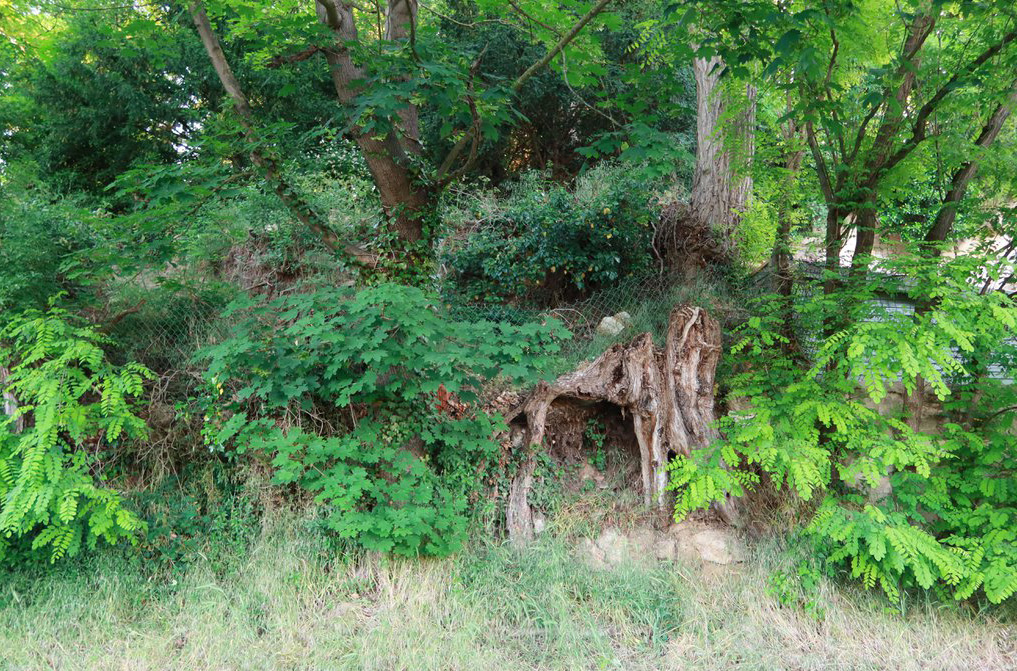
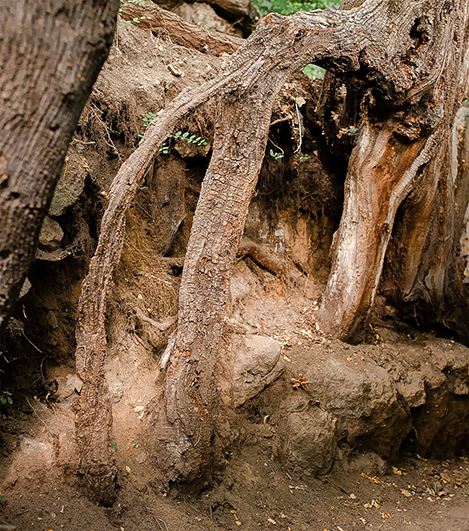
With Jo’s note: This letter, evidently his penultimate one to Theo, was found on Vincent’s body after his suicide on the27th. There is a note in Theo’s handwriting on it: “Letter found on him on July 29."
Auvers, 23 July 1890.
My dear brother,
Thanks for your kind letter and for the 50 fr. note it contained
There are many things I should like to write you about, but I feel it is pointless. I hope you have found these gentlemen favorably disposed toward you.
Your reassuring me as to the state of peace of your household was not worth the trouble, I think, having seen the other side of it for myself. And I quite agree with you that rearing a boy on a fourth floor is a hell of a job for you as well as Jo.
Since it is going well, which is the main thing, I should insist on things of less importance. My word, before we have a chance of talking business more calmly, there is probably a long way to go.That is all I want to say, that I noted it with a certain fright and I cannot hide it. But that is all there is to it.
The other painters, whatever they think of it, instinctively keep themselves at a distance from discussions about actual trade.
Well, the truth is, we cannot speak other than by our paintings. But still, my dear brother, there is this that I have always told you, and I repeat it once more with all the earnestness that can be imparted by an effort of a mind diligently fixed on trying to do as well as one can - I tell you again that I shall always consider that you are something other than a simple dealer in Corots, that through my mediation you have your part in the actual production of some canvases, which even in the cataclysm retain their calm.
For this is what we have got to, and this is all or at least the chief thing that I can have to tell you at a moment of comparative crisis. At a moment when things are very strained between dealers in paintings by dead artists, and living artists.
Well, my work to me, I risk my life on it, and my reason has half foundered - all right - but you are not one of those dealers in men, as far as I know, and you can take sides, I find, truly acting with humanity, but what is the use?
And yet, one of the main messages of the scholars is that van Gogh wasn't the crazed visionary whose work was fuelled by the fire of his madness, as was wrongly depicted after his death. In fact, his brilliant paintings were created in spite of his illness... “When he was really ill he couldn’t paint."
Future confirmation of the relevance of our skull-like brushstrokes by the scientists could further assure the theory of Van Gogh Museum Amsterdam and the scholars, that Vincent indeed committed a planned suicide and that he wasn't murdered as suggested in some publications.
Dr. Gachet: A few hours after the shooting, Vincent’s doctor, Paul Gachet, wrote to the artist’s brother, Theo van Gogh, to break the news that “he has wounded himself”. Dr. Gachet had inspected the wound and spoken with Vincent. Had there been anything to suggest possible foul play, he would presumably not have let the matter rest. Two weeks after Vincent’s death, he wrote again to Theo, explicitly using the word “suicide”.
Theo: Theo, who rushed to his brother’s bedside and conversed with him during his final 12 hours, was convinced it was suicide. Three days after Vincent’s death, he wrote an emotionally charged letter to his wife Jo: “One of his last words was: this is how I wanted to go; it took a few moments; then it was over; he found the peace he hadn’t been able to find on earth.” Had Theo any reason to believe his beloved brother might have been shot by someone else, he would surely have informed the police.
Friends: Emile Bernard, Van Gogh’s closest friend, attended the funeral and spoke with Dr Gachet and Theo. Dr. Gachet told Bernard that he had hoped to save his patient’s life, but Vincent had warned him that “then I’ll have to do it over again”. Two days after the funeral, Bernard wrote a detailed account to the critic Albert Aurier: “He killed himself. On Sunday evening he went into the countryside around Auvers, placed his easel against a haystack and went behind the château and fired a vrevolver shot at himself.” Vincent had “done it in complete lucidity”, with a “wish to die”.
Paul Gaugain: In Gauguin’s memoir "Avant et Après": he wrote that “van Gogh shot himself in the stomach”. Although Gauguin was in Brittany at the time, he remained in touch with Vincent’s circle of friends. Gauguin knew van Gogh well from their time together in the Yellow House in Arles, where their collaboration had come to an abrupt end with the ear incident, and he was only too aware of his friend’s fragile mental condition.
Police: No police records about the shooting survive, but Bernard also informed Aurier that the innkeeper, Arthur Ravoux, had told him about “the gendarmes who came to his bed to reproach him for an act for which he was responsible”. His daughter, Adeline Ravoux (who was 13 at the time of the incident), later reported that her father had often spoken about van Gogh. The artist had told the police: “What I have done is nobody else’s business. I am free to do what I like with my own body.” Surely the police would have followed up if they had harbored any suspicions of foul play. Adeline even named one of the gendarmes as Rigaumont.
The church: The church believed it was suicide. Henri Tessier, the Catholic priest in Auvers, refused to allow the funeral service to be held in his church, or to provide the parish hearse to carry Van Gogh’s body to the cemetery. Tessier was presumably concerned that the Protestant artist had sinned by committing suicide. Theo then needed to amend the printed funeral invitations.
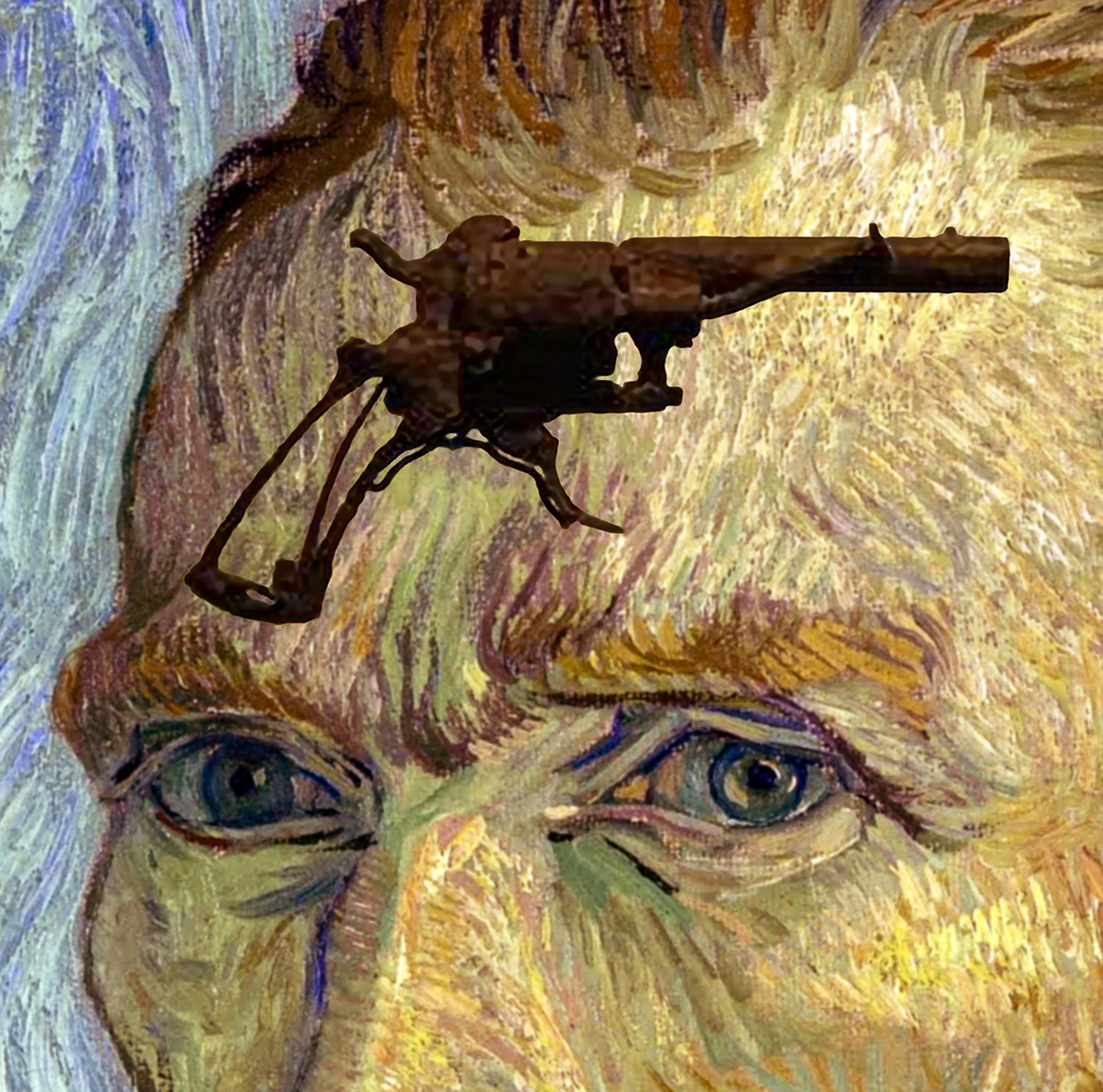 The gun. The recent emergence of the gun is further
evidence for suicide. The corroded gun that is said to have killed van
Gogh was displayed and auctioned in Paris in June, fetching €162,500. It
had been found around 1960 by a farmer, abandoned in a field in the area where the artist is believed to have suffered the wound. If it
is the van Gogh gun, which is very likely (although not certain), then it's discovery near the surface of the ground suggests it was abandoned rather than hidden. If it was Secrétan who had fired the fatal shot, then surely he would have hidden the weapon properly, perhaps by burying it more deeply or throwing it in the nearby river Oise. He would have fired more shots to silence Vincent forever. But if van Gogh had pulled the trigger, he would have immediately fallen, dropping the gun.
The gun. The recent emergence of the gun is further
evidence for suicide. The corroded gun that is said to have killed van
Gogh was displayed and auctioned in Paris in June, fetching €162,500. It
had been found around 1960 by a farmer, abandoned in a field in the area where the artist is believed to have suffered the wound. If it
is the van Gogh gun, which is very likely (although not certain), then it's discovery near the surface of the ground suggests it was abandoned rather than hidden. If it was Secrétan who had fired the fatal shot, then surely he would have hidden the weapon properly, perhaps by burying it more deeply or throwing it in the nearby river Oise. He would have fired more shots to silence Vincent forever. But if van Gogh had pulled the trigger, he would have immediately fallen, dropping the gun.
 This painting "View at Auvers with Church" was made about a week before the suicide and is definitely pointing towards "death in the cornfield". It cannot be "a secret message" to these two local boys: "Please kill me here in this field". And for Vincent, it would be a shear impossible job in this small french village Auvers, to secretly organize the two drunken boys and the loaded gun, and all this at the right time and at the right specific location. And during all this hassle Vincent had to paint his suicide note, the 50x100cm huge ultimate masterpiece: "TreeRoots"...
This painting "View at Auvers with Church" was made about a week before the suicide and is definitely pointing towards "death in the cornfield". It cannot be "a secret message" to these two local boys: "Please kill me here in this field". And for Vincent, it would be a shear impossible job in this small french village Auvers, to secretly organize the two drunken boys and the loaded gun, and all this at the right time and at the right specific location. And during all this hassle Vincent had to paint his suicide note, the 50x100cm huge ultimate masterpiece: "TreeRoots"...
René Secrétan. The purported killer, never confessed and indeed claimed he had left Auvers before the shooting The only occasion on which Secrétan publicly spoke about van Gogh was in an interview published in 1957, when he was aged 82. This was just a few months before his death. Secrétan never said he fired the shot, instead of saying Vincent had somehow got hold of a gun, which had been in the young man's possession. Secrétan also had an apparent alibi, since he claimed to have left Auvers some days before the shooting. Although there is no way of verifying his statements, in my mind there is nothing in the interview which represents prima facie evidence that he might have been guilty of murder or manslaughter. In any case, it must be extremely rare for a victim fatallyb injured in a shooting by someone else to claim it was actually a suicide attempt. To add to the implausibility, why should Secrétan, if guilty, have voluntarily given an interview about van Gogh nearly 70 years afterwards, at a time when he was under no suspicion?
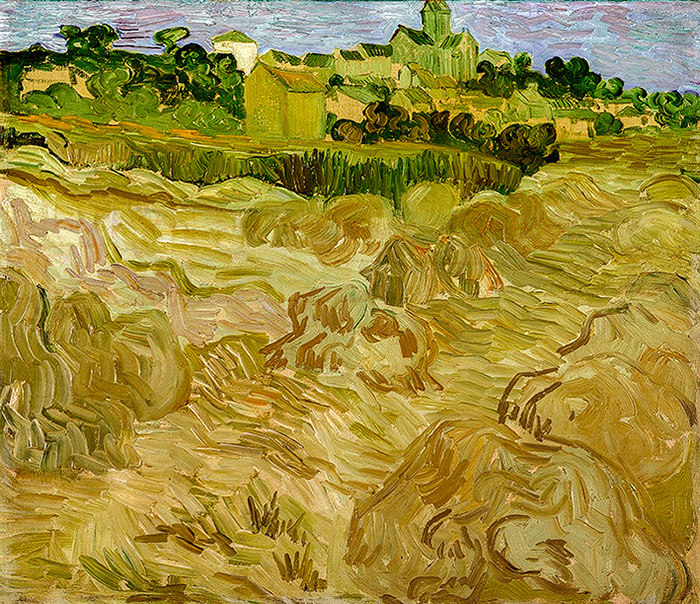 Vincent had painted
again
and again his "wheatfield
of execution" in front of the village Auvers in
those
weeks before his suicide.
He was more and more
convinced on his choice
for the location of the
execution of his suicide.
Here You can see
the very cornfield where
it had to happen....
Vincent had painted
again
and again his "wheatfield
of execution" in front of the village Auvers in
those
weeks before his suicide.
He was more and more
convinced on his choice
for the location of the
execution of his suicide.
Here You can see
the very cornfield where
it had to happen....
The key-people at the time believed Vincent van Gogh had shot himself. Suicide was then condemned by the Catholic church and regarded by society as wrong. Had Vincent’s family and friends had any suspicions that someone else was responsible, they surely would have voiced their concerns. And why point the finger at Secrétan? The only substantive information on his links with van Gogh comes from his 1957 interview, in which he said nothing to suggest he was guilty of murder. What would be useful in determining whether it was suicide or murder would be forensic evidence about the nature of the wound, but there is little information. Dr. Gachet, who died in 1909, never spoke out about the wound during his lifetime, and the descriptions, given after his death by his son were very brief (on the color of the skin on the adjacent skin, its location on the body and the angle of the shot) and these details have recently been subject to different interpretations.
Vincent had tried to kill himself a year before.
In April 1889, four months after mutilating his ear, Vincent had written to
Theo: “If I was without your friendship I would be sent back without remorse to
suicide, and however cowardly I am, I would end up going there.” A few
months later he tried to poison himself by eating his paints and turpentine,
but fortunatel his doctor saved him. A few days after his recovery, Dr.
Théophile Peyron told Theo that Vincent’s “ideas of suicide have disappeared”.
Vincent himself reported that “I’m trying to get better now like someone who,
having wanted to commit suicide, finding the water too cold, tries to
catch hold of the bank again”. He was undoubtedly a vulnerable individual.
Vincent faced a difficult time in the final months of his life: In
May 1890, after a year in the asylum just outside Saint-Rémy-de-Provence,
Vincent moved north, to the village of Auvers. Throughout his career,
Theo had been his closest confidante and had provided a regular financial
allowance. But Theo, an art dealer in Paris, had recently married and then
had a son in January 1890. Vincent was therefore concerned that a wife
and an infant would mean he might lose much of his brother’s emotional
and financial support. He was also worried about Theo’s recent problems at
work with the owners of the gallery. Although most of the time
Vincent could cope with the challenges of his life, he was upset.
Meanwhile: Theo recognised that Vincent was experiencing problems. In a letter dated 22 July, he wrote, "I hope, my dear Vincent, that your health is good, and since you say that you write with difficulty, and don't talk about your work I am a little afraid that there is something troubling you or not going right."
The painter was also exhausted from working hard in the weeks before that fatal day, the 27th of July 1890, and the high standards he set for himself. He was uncertain about the future and felt that he had failed, as a man and as an artist.
We, therefore, have to make a judgment on what seems
the more likely explanation. Should we accept van Gogh’s words that
he had decided to end his life? Or does Secrétan’s
interview suggest it was he who pulled the trigger? For me, the
answer is clear. As Theo put it so poignantly: Vincent then “found the peace he hadn’t been able to find on earth”.
Vincent: "For myself, I can only say at the moment that I think we
all need rest. I feel.... I failed.... And the prospect grows
darker, I see no happy future at all."
This sad and lonely self-crucifixion was his final
decisive solution to end all his sufferings.
Vincent’s suicide has become the grand finale of the story of the martyr for art...
By the end of the day July 27th Vincent was finishing
painting the big
"TreeRoots". In the painting his dead body was laying
between the roots.
This was his suicide note..... Around 6pm he brought the easel and
the painting back to Ravoux....
and started to
finally execute his suicide-plan.
All was ready... and he was ready...
He had the loaded ready gun with him that he gotten from
the owner of
the inn, Arthur Ravoux to scare off the always annoying
crows while
he was painting.
The evening was falling and Vincent went up the hill and
in the him so
familiar cornfield that he had painted and explored all
the time .... he
walked awhile along the field, got behind the castle and
....... he .....
anxious and hesitating, shot himself in his chest and fell
to the ground.
Later in the night and when still laying in the field,
Vincent gained consciousness, and
as he confided later to Theo, tried to find the gun to finish off the job. But he could not find it as it
was getting darker.
So.... badly 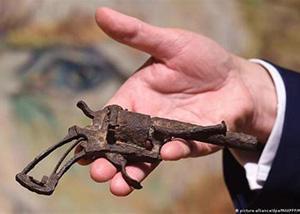 wounded of the single shot
in the chest he would get down
the mountain and walk back to Ravoux-Inn. Adeline Ravoux,
the
innkeeper's daughter who was only 13 at the time, clearly
recalled
the incidents of July 1890. In an account written when she
was 76,
reinforced by her father's repeated reminders, she
explained how on
27 July, van Gogh left the inn after breakfast. When he
had not
returned by dusk, given the artist's regular habits, the
family became
worried. He finally arrived after nightfall, probably
around 9 pm, holding his stomach. Adeline's mother asked whether there was a
problem.
Van Gogh started to answer with difficulty, "No, but I
have..." as he
climbed the stairs up to his room. Her father thought he
could hear
groans and found van Gogh curled up in bed. When he asked
whether
he was ill, Vincent showed him the wound near his heart
and van Gogh
admitted he had set out for the wheatfield where he had
recently been
painting and had attempted suicide by shooting himself.
wounded of the single shot
in the chest he would get down
the mountain and walk back to Ravoux-Inn. Adeline Ravoux,
the
innkeeper's daughter who was only 13 at the time, clearly
recalled
the incidents of July 1890. In an account written when she
was 76,
reinforced by her father's repeated reminders, she
explained how on
27 July, van Gogh left the inn after breakfast. When he
had not
returned by dusk, given the artist's regular habits, the
family became
worried. He finally arrived after nightfall, probably
around 9 pm, holding his stomach. Adeline's mother asked whether there was a
problem.
Van Gogh started to answer with difficulty, "No, but I
have..." as he
climbed the stairs up to his room. Her father thought he
could hear
groans and found van Gogh curled up in bed. When he asked
whether
he was ill, Vincent showed him the wound near his heart
and van Gogh
admitted he had set out for the wheatfield where he had
recently been
painting and had attempted suicide by shooting himself.
Doctor Gachet was called upon but he considered Vincents
situation as
hopeless. Ravoux and Hirschig spent the night at van
Gogh's bedside.
The artist sometimes smoked, sometimes groaned but
remained silent
almost all night long, dozing off from time to time. The
following morning,
two gendarmes visited the inn, questioning van Gogh about
his attempted
suicide. In response, he simply replied: "My body is mine
and I am free to
do what I want with it. Do not accuse anybody, it is I
that wished to
commit suicide. As soon as the post office opened on
Monday morning,
Adeline's father sent a telegram to Vincent's brother
Theo, who
arrived from Paris by train during the afternoon. During
the afternoon
and night the two brothers talked while Vincent smoked his
pipe. Adeline
Ravoux explains how the two of them watched over van Gogh
who fell
into a coma and died at about one o'clock in the morning;
his death
certificate records the time of death as 1.30am.
In a letter to his sister Lies, Theo told of his brother's
feelings just before
his death: "He himself wanted to die. When I sat at his
bedside and said
that we would try to get him better and that we hoped that
he would
then be spared this kind of despair, he said, "La
tristesse durera toujours".
(The sadness will last forever). I understood what he
wanted to say
with those words. In her memoir of December 1913, Theo's
wife
Johanna refers first to a letter from her husband after
his arrival at
Vincent's bedside: "He was glad that I came and we are
together all
the time... Poor fellow, very little happiness fell to his
share, and no
illusions are left him. The burden grows too heavy at
times, he feels so
alone..." And after Vincent's death he wrote: "One
of his last words
was: 'I wish I could pass away like this,' and his wish
was fulfilled. A few
moments and all was over. He had found the rest he could
not find on
earth..."
Émile Bernard, an artist and friend of van Gogh, who
arrived in Auvers
on 30 July for the funeral, tells a slightly different
story, explaining that
van Gogh went out into the countryside on the Sunday
evening, "left his
easel against a haystack and went behind the château and
fired a
revolver shot at himself." He tells how van Gogh had said
that "his suicide
had been absolutely deliberate and that he had done it in
complete
lucidity... When Dr Gachet told him that he still hoped to
save
his life, van Gogh replied, 'Then I'll have to do it over
again.'"
In her memoir of December 1913, Theo's wife Johanna refers first to a letter from her husband after his arrival at Vincent's bedside: "He was glad that I came and we are together all the time... Poor fellow, very little happiness fell to his share, and no illusions are left him. The burden grows too heavy at times, he feels so alone..." And after his death, he wrote: "One of his last words was, 'I wish I could pass away like this,' and his wish was fulfilled. A few moments and all was over. He had found the rest he could not find on earth..."
 Theo wrote to his wife Jo
three days later after he had spoken to Vincent
before he died: “One of his last words was: this
is how I wanted to go and it
took a few moments and then it was over and he
found the peace he hadn’t
be able to find on earth.”
Theo wrote to his wife Jo
three days later after he had spoken to Vincent
before he died: “One of his last words was: this
is how I wanted to go and it
took a few moments and then it was over and he
found the peace he hadn’t
be able to find on earth.”
The coffin was carried to the hearse at three o'clock. The
company climbed
the hill outside Auvers in hot sunshine, Theo and several
of the others
sobbing pitifully. The little cemetery with new tombstones
was on a little hill
above fields that were ripe for harvest. Dr Gachet, trying
to suppress his tears,
stammered out a few words of praise, expressing his
admiration for an
"honest man and a great artist... who had only two aims,
art and humanity."
Van Gogh was particularly productive during his last few
weeks in Auvers,
completing over 70 paintings as well as a number of
drawings and sketches.
They cover landscapes, portraits and still lifes. Some of
them appear to
reflect his increasing loneliness while many others, with
their bright colours,
convey a more positive attitude. The letters he wrote
during his last two
months offer a considerable amount of background on van
Gogh's
relentless will to paint coupled with frequent periods of
losing courage
and hope.
Vincent Van Gogh, now long departed into his own dark night, must be wondering what madness causes people to pay hundreds of millions of dollars for paintings he could not even give away during his lifetime. I cannot even imagine, as I walk among his varying depictions of dream, nightmare, love, and life, what he would have thought of this strange turn of fate.
+++++++++++++++++++++++++
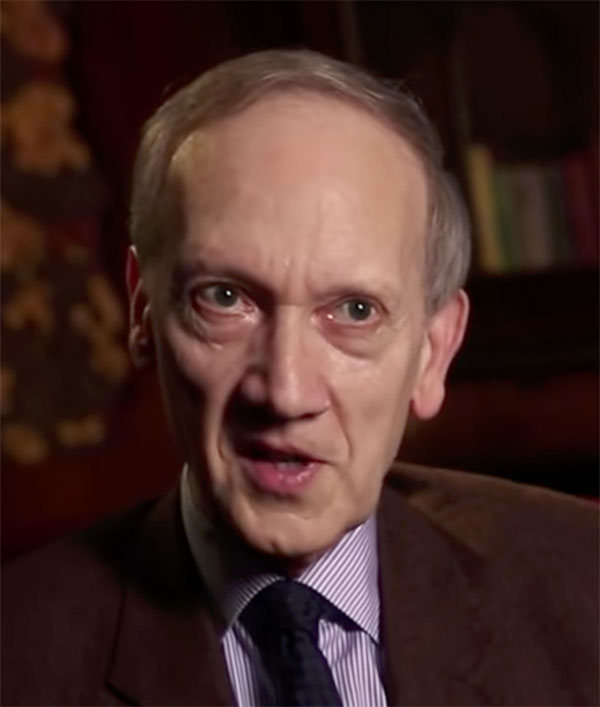
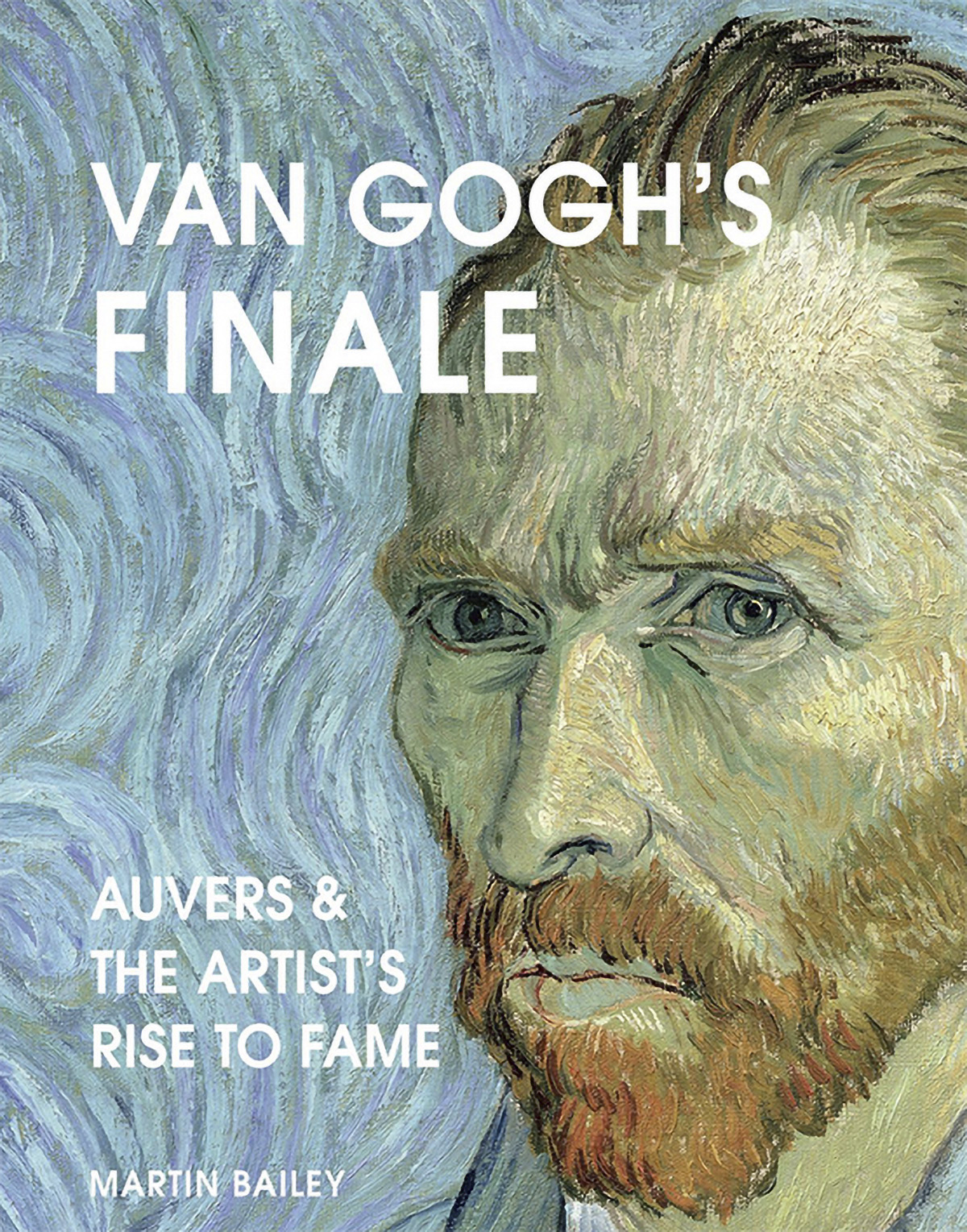
Martin Bailey confirmed van Gogh's suicide in "ART-NEWSPAPER"
Link to the article Martin
Bailey
Link to the article Martin
Bailey
Read the full story of Vincent's
final months in a beautiful
full-color book called "FINALE",
written by Martin Bailey,
the famous "van-Gogh-connoisseur".
Copying and republishing of (parts of) this website is
only allowed with mentioning the source: www.art-aruba.com
Copyright JCvanRoekel 2021
jancvanroekel@gmail.com